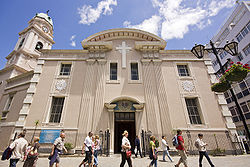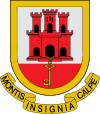- Cathedral of St. Mary the Crowned
-
Cathedral of St. Mary the Crowned 
The exterior of the Cathedral of St. Mary the Crowned.36°08′23″N 5°21′13″W / 36.139672°N 5.35366°WCoordinates: 36°08′23″N 5°21′13″W / 36.139672°N 5.35366°W Location 215 Main Street Country  Gibraltar
GibraltarDenomination Roman Catholic Website Gib Cathedral History Former name(s) Iglesia de Santa Maria la Coronada y San Bernado Founded 20 August 1462 Founder(s) Catholic Monarchs Dedication St. Mary the Crowned Dedicated 20 August 1462 Consecrated 20 August 1462 Significant past bishop(s) See list of Roman Catholic Bishops Significant associated people Fr. Juan Romero de Figueroa Architecture Status Cathedral Functional status Active Architect(s) Various Architectural type Mixed Style Mixed Specifications Number of domes 1 Clergy Bishop(s) Mons. Ralph Heskett Priest(s) Fr. Paul Bear The Cathedral of Saint Mary the Crowned is a Roman Catholic cathedral in Gibraltar. It is the primary centre of Catholic worship in the Diocese of Gibraltar.
Contents
History
15th Century
The original building of the current cathedral was built during the Spanish period. Just after the conquest of the city to the Moors, the main mosque was decreed to be stripped of its Islamic past[1] and consecrated as the parish church (named Santa Maria la Coronada y San Bernardo[2]). However, under the rule of the Catholic Monarchs, the old building was demolished and a new church was erected, in Gothic style. The cathedral's small courtyard is the remnant of the larger Moorish court of the mosque. The Catholic Monarchs' coat of arms was placed in the courtyard where it can still be seen today. The cathedral extended to the opposite side of what is now Main Street.[1]
18th to 20th Century
The church of St.Mary the Crowned was the only Catholic church or institution that was not ransacked by the troops that took over the city in 1704. It was successfully protected by its staunch pastor, Juan Romero, his curate, and his bell-ringer.[3] Thus, it is the only place where Catholic worship has been taken place uninterruptedly from the definite Christian re-conquest of the town.
Due to the building being severely damaged during the 1779–1783 Great Siege, in 1790 the then Governor of Gibraltar Sir Robert Boyd offered to rebuild the cathedral in return for part of the land on which the building originally stood in order to re-route Main Street. The reconstruction took place in 1810 and the opportunity was also taken to widen Main Street. The clock tower was added in 1820 and in 1931 restoration work was carried out on the cathedral and the current west façade erected to replace the poorer one built in 1810.[1]
Until the 19th century, anyone who died in Gibraltar had the right to be buried under the cathedral floor. Bishops are buried in a crypt beneath the statue of Our Lady of Europe.[1]
In 1943, Władysław Sikorski's coffin lay in state here, after his plane crashed into the sea just off Gibraltar.
See also
- San Roque, Cádiz (The original statue of St Mary was moved there in 1704, following the British takeover of Gibraltar)
Gallery
-
The exterior of the Cathedral of St. Mary the Crowned. The statue of the soldier outside the Cathedral is a gift from the Corps of the Royal Engineers to Commemorate the formation in Gibraltar of the Company of Soldier Artificers in 1772, which later became the Royal Engineers in 1856.[4]
References
- ^ a b c d History of the Cathedral of St Mary the Crowned.
- ^ "A Short History of the Diocese of Gibraltar". http://www.catholicdiocese.gi/diocese/historyofthediocese.html.
- ^ Jackson, William (1990). The Rock of the Gibraltarians. A History of Gibraltar (2nd ed.). Grendon, Northamptonshire, UK: Gibraltar Books. pp. 99–101. ISBN 0-948466-14-6.
- ^ 300 Years of British Gibraltar 1704-2004 by Peter Bond
External links
- Cathedral information and photos of interior (from the Diocese of Gibraltar)
- Illustrated article
Categories:- 1460s architecture
- Buildings and structures completed in 1820
- 15th-century Roman Catholic church buildings
- Cathedrals in Gibraltar
- Roman Catholic cathedrals in Europe
- Former mosques
- Conversion of non-Christian places of worship into churches
Wikimedia Foundation. 2010.






